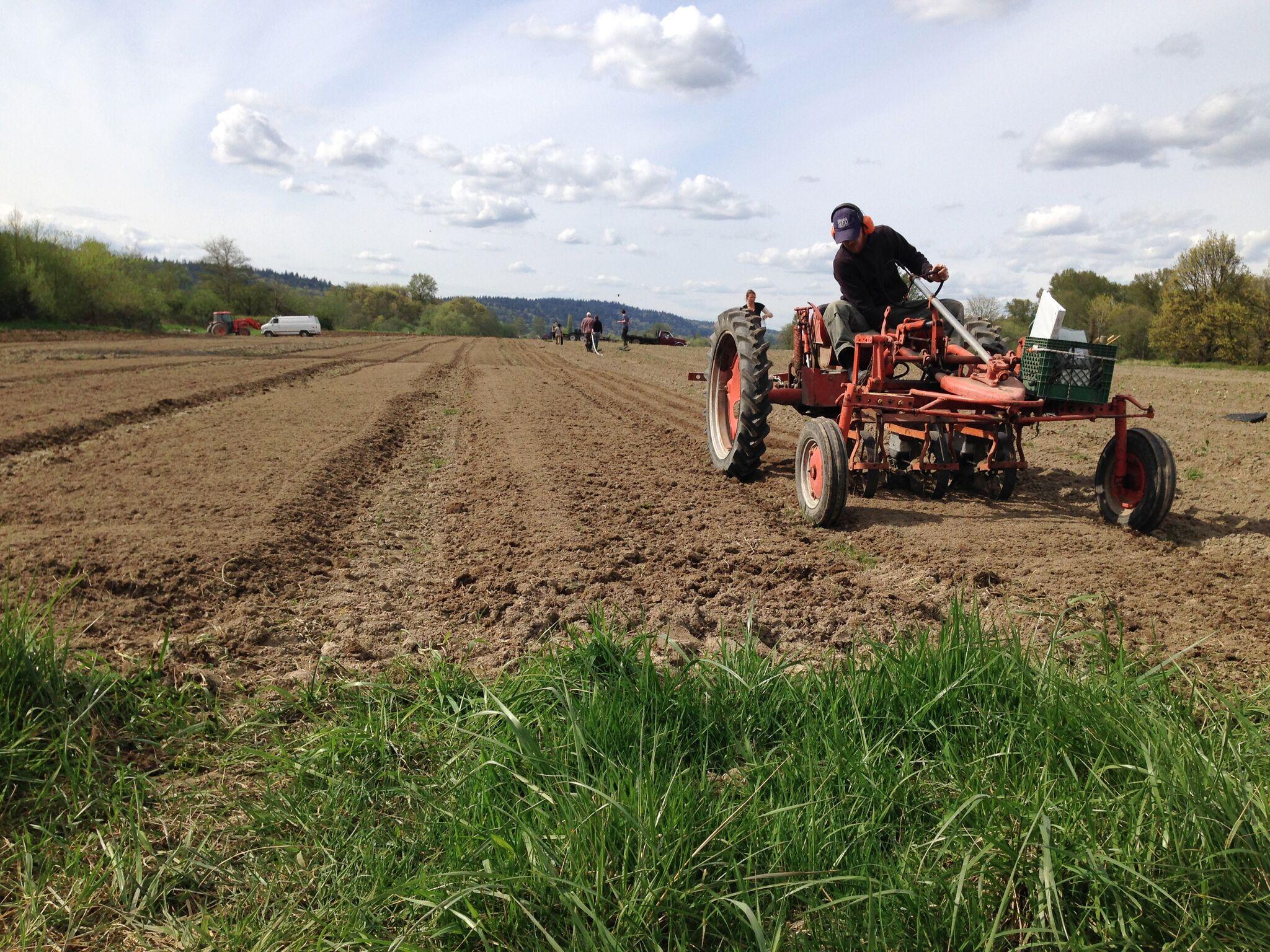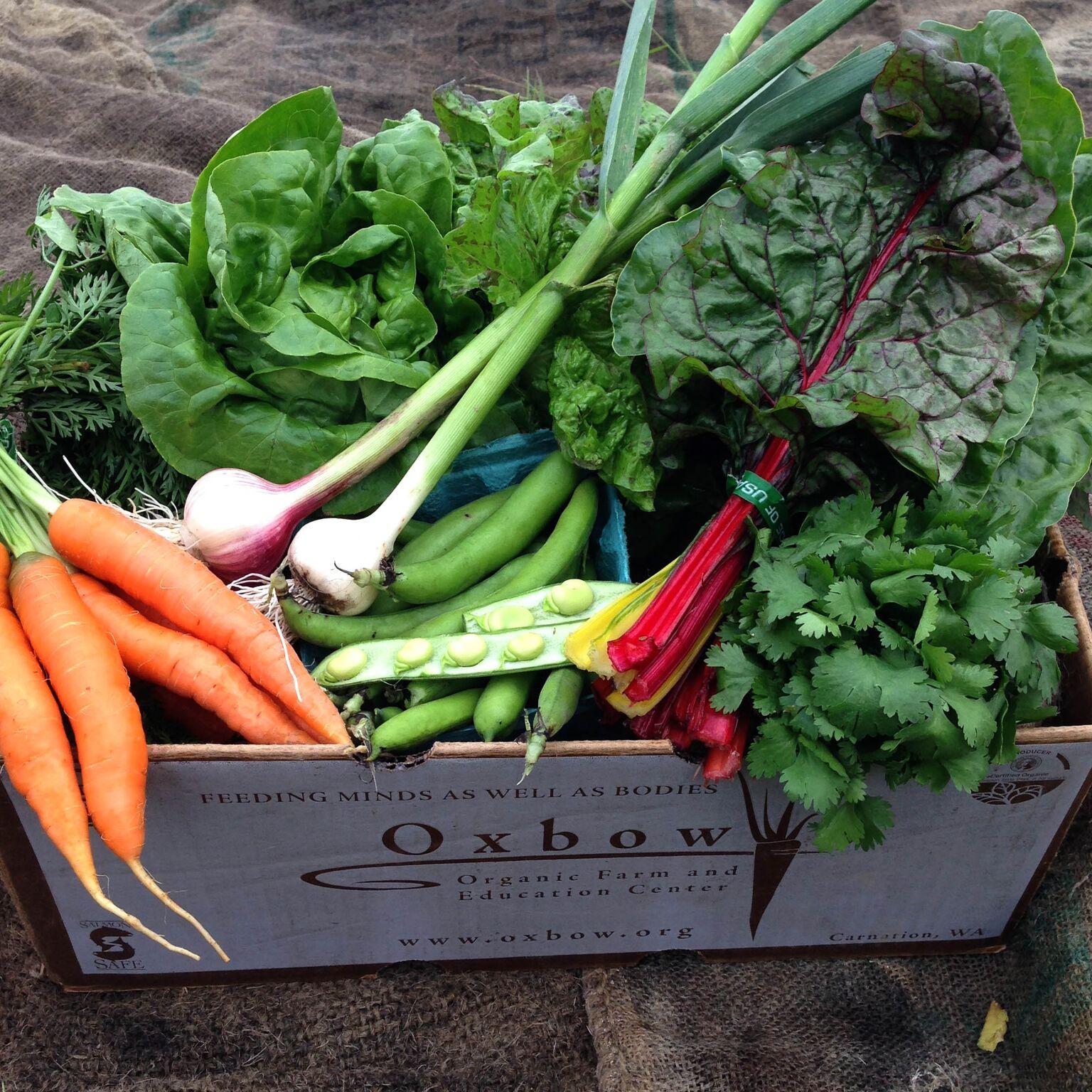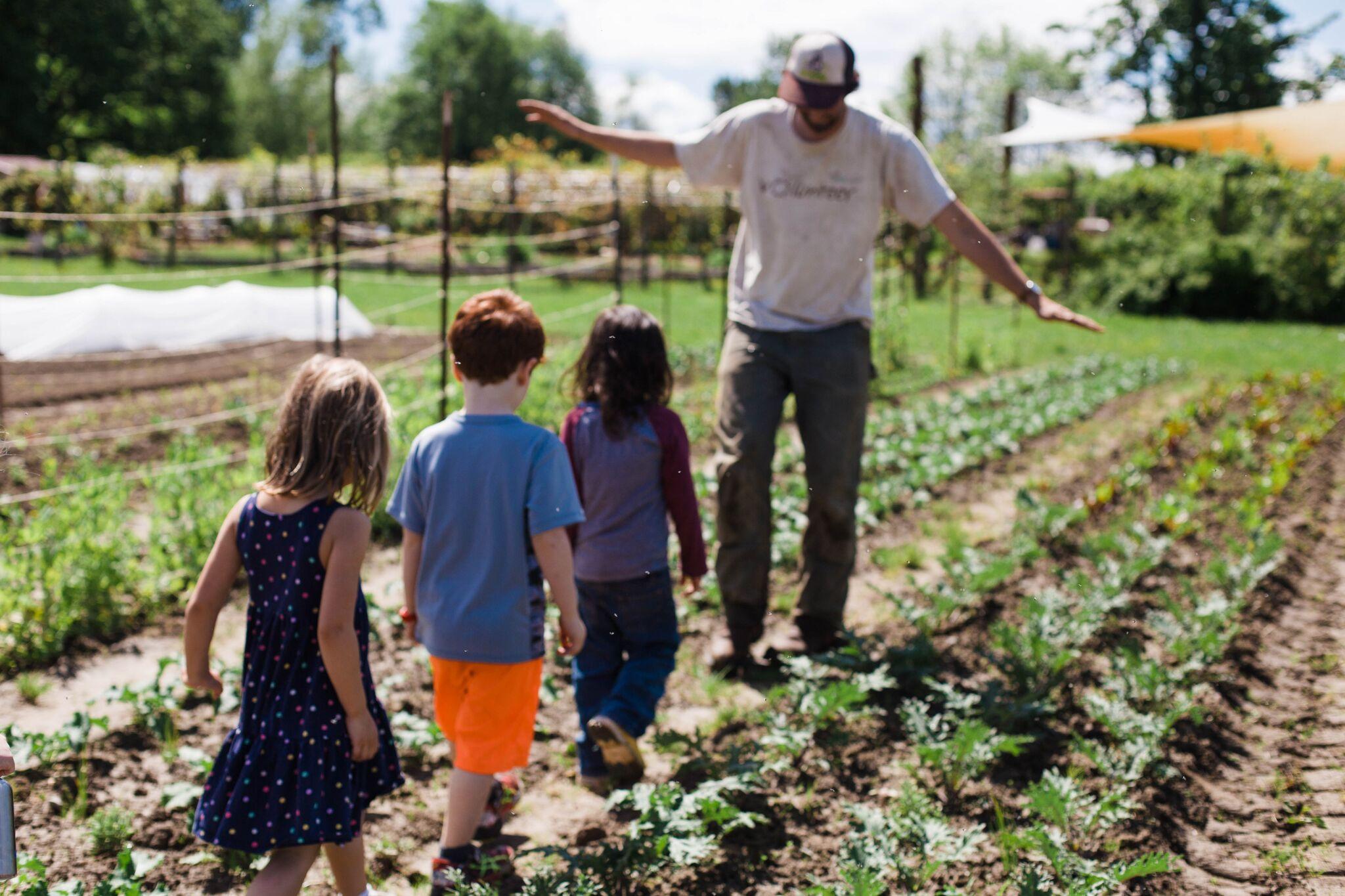The LocalHarvest Blog
18 Oct Wed 2017
Community in Action: Portland, Oregon’s Food Works Farm and CSA
These days we may know a lot about where our food comes from, but despite the broad array of choices in many grocery stores, access to good food is often a privilege rather than a given. More than ever, it is important to recognize communities who come together to provide sustenance to people who need it and support the good work they do. With this in mind, I looked forward to the chance to visit the Food Works Farm of Sauvie Island, near Portland Oregon, to meet some of the people who have made it their vision to make this happen.
Food Works Farm is an offshoot of what began as a grassroots community garden project at the St. Johns Woods apartments, a North Portland public housing community, in 2001. The St. Johns Woods garden (now called Cathedral Garden Apartments and Village Gardens), came about through a strong community effort, and was the first place in the country to offer community garden space at a publicly owned subsidized housing location. During the time that Village Gardens became more established, youth from the community created a plot for growing salad greens for sale. Asdemand for the salad greens increased, the youth expanded the business onto donated land on Sauvie Island, granted by Metro, the Metropolitan Planning Organization for the Portland region. Eventually thisgave rise to the current Food Works Farm and its youth employment program.
The Food Works Farm is a 2.5 acre certified organic farm, nestled between a public orchard and fields run by Sauvie Island Organics, a well-known, established organic CSA serving the Portland area. Food Works Farm produces food for its own CSA, grocery and restaurant accounts, and farmers markets, locatedmostly within the North Portland community. On the hot summer afternoon of my visit, youth were gathering at the Food Works’ shed after preparing a shared lunch at the farm kitchen. Settling on their plan for the afternoon, they divvied up totes used to load up the tomatoes and peppers they’d be harvesting to fill an order for a local grocery.
I met with Victor Montano, Food Works Farm Retail Coordinator, and Leslie Heimer, Food Works Program Supervisor, to talk about the history of Food Works Farm, the youth leadership program, and Victor’s role at the farm. Victor’s story starts out on a bus ride in North Portland. During their commute his mom and brothers were caught in a water balloon fight on the bus, and in the ruckus they met Leslie, thesupervisor at the farm. Leslie encouraged Victor and his brothers to apply to the summer youth leadership program and that summer he joined Food Works, working at the farm. From there, while in high school, he returned to join in the Academic Year Program, and then stayed on as the farm’s Retail Coordinator during the summer. Reflecting on his three years at the farm, Victor says:
“I’m a little biased, because my best friend works here, but [I like] working with others, andwith people who want to work together [with you]. Here you start in the summer program, so you build all the way through together. You spend quality time with [your friends/co-workers]. You’re building a friendship, coming here everyday. That’s what I like the best, working with friends.”
These days, Food Works receives far more applicants than they can take. Leslie says that in 2017 they received more than five times moreapplicants than they could enroll in the program.She no longer needs to recruit for applicants, since word of mouth is enough to spread the word. When asked if they’d ever consider growing the program, she says yes, but there are reasons to keep things small:
“We have a two-person adult staff at Food Works. We’ve been bigger before, and someday we’d love to grow, but we found that working with one crew is more effective. Everybody feels more a part of a team, and we are able to provide more access and attention to each person that way. We’re part of a larger organization called Village Gardens, so we can’t expand exponentially. We want to stay within our North Portland community. Those are our [long-term] relationships. They’re who we’re close to and who we answer to.”
Youth in the 8-week summer leadership program take public transportation to get to their workday. It is a commitment: a bus ride to Sauvie Island, then a walk up the road to the farm itself. Oregon summers are hot, and a work day is physically demanding. Lunchtime usually includes a break for a game and potentially a little spray from one of the garden hoses. While in the program, youth learn about planning, growing and selling produce, as well as developing leadership skills, like teamwork, accountability and conflict resolution . At the end of their workday, the youth gather together to review “positives and deltas” from the day: what went well, and what could use a little more practice. Positives for this day were the beautiful produce they’d picked, teamwork, and celebrating the birth of one of their friend’s babies. Deltas includedrecipe-tweaking on the baked onion rings for lunch, time-management with one less person on the crew and that it was challengingly hot that day.
CSA shares from the Food Works farm are delivered to pickup locations in the north Portland area, and some are offered at a discounted rate to people in recovery at a local addiction rehabilitation center. For many it is a unique opportunity to obtain thefresh, healthy food so necessary to our wellbeing. Not only can people make the choice to buy into the CSA and cook with the freshest of produce, Food Works also offers cooking demonstrations based on what is in the CSA box. In addition to the raw ingredients comes knife skills, proper storage, and food preparation, leading to more confidence and enjoyment in the kitchen.
In winter the Farm Supervisors and Academic Year youth team review the farm’s retail accounts and make plans for the upcoming spring and summer seasons. As Retail Coordinator at the farm, Victor heads up the accounting and outreach to community retailers:
“In general the way it works is thatwe do business planning during the school year, then we reach out to [local businesses] with a partnership proposal. My favorite is Village Market and New Columbia (part of Village Gardens). We’ve worked with New Seasons (a B-corp organic grocery chain) for many years, actuallysince we started. They’re very much in support of community programs. They have always bought produce from us. The heirloom tomatoes we’re harvesting right now are going to New Seasons. New Seasons also coordinates volunteer groups that come out to the farm.”
After we had finished our chat in the shade of the farm packing shed, Victor showed me around the Food Works fields, pointing out which crops were ready for harvest, which were finishing up (giant Walla-Walla onions were just harvested and curing), as well as crops going the long haul, like winter squash. He explained how the youth work with the farm supervisors to decide which crops to grow, when, and how much each season. Crop varieties are often chosen for their past performance: whether they providedproviding good yields, worked well in Portland’s climate, and of course, the taste test. Victor’s new picks this year,robust clumps of chives and lemongrass, were approved by group consensus during planning this past winter.
To me, this is one of the delights of CSA and small-scale farming: where people from the community are encouraged to come visit and participate, to get to know how their food is grown, and to know the people that produced it. The Food Works farm takes this even further, providing youth with the opportunity to give to their community, learn new ways of working together, job training, and commitment to a cause. It isn’t all rainbows, there are “positives and deltas”, farming takes a lot of work, and teamwork takes practice and patience. But we all depend on our food systems, and sharing food brings us a lot of basic joy.
Programs like The Food Works Farm thrive off community involvement with other small businesses working directly with the farm, community volunteers, and even some input like USDA grants. It’s the energy of community and our interdependence that encourages independence and growth, which then cycles around again. However you choose, the next time you’re browsing in the grocery aisle, farmers market, or opening your box of food, we invite you to pause and consider again the people who made it all possible.

26 Jun Mon 2017
Oxbow Farm and Conservation Center: Pioneers of Good Food, Community and Land Stewardship
 Last month, in the midst of gearing up for the CSA season, Oxbow Farm Manager Adam McCurdy took time to talk with LocalHarvest about farming, community, sustainability and much more. Oxbow Farm & Conservation Center is a unique non-profit organization situated along the verdant Snoqualmie River in Carnation, just 30 miles from Seattle, Washington. Oxbow hosts an impressive variety of projects, including their 500 member CSA program, outdoor education and summer camps for kids, food gleaning programs, and a native plant nursery.
Last month, in the midst of gearing up for the CSA season, Oxbow Farm Manager Adam McCurdy took time to talk with LocalHarvest about farming, community, sustainability and much more. Oxbow Farm & Conservation Center is a unique non-profit organization situated along the verdant Snoqualmie River in Carnation, just 30 miles from Seattle, Washington. Oxbow hosts an impressive variety of projects, including their 500 member CSA program, outdoor education and summer camps for kids, food gleaning programs, and a native plant nursery.
LocalHarvest: What is your role at Oxbow and what got you into farming?
Adam: I’ve been with Oxbow since 2006, and I’ve been farming since 1999 in different regions: in the Willamette Valley outside of Portland, the Methow Valley in Eastern Washington, and now currently in the Snoqualmie Valley. I first became interested in farming while working with an Americorps program in Maine, doing environmental education and forest management, and as a result I became interested in food systems more generally. From there, I started helping with different gleaning efforts in Maine, working towards hunger relief, which is now a major aspect of what we’re doing at Oxbow.
LH:How does the gleaning program at Oxbow work?
Adam: The development of our gleaning and partnering with hunger relief organizations has been quite an evolution. We’ve had to find solutions to questions like: how do you open your land up to volunteers who are willing to come and glean? How do you get the food to the food bank? Most importantly, how do you serve the populations that need local nourishing food, probably more than anyone?
Over time, we’ve worked with organizations such as Rotary First Harvest, Foodlink, and LifeLine, in a few different ways. The first task is to bring volunteers out to the farm to harvest, and the second is get the food to the food pantries. We’ve also developed a purchasing program, so not only are we working with the food bank on a donation basis, but the food bank helps to support the local farm financially. Our gleaning program was managed through Rotary First Harvest and Americorps for a few years, and then HopeLink created a permanent gleaning coordinator position, who manages all the volunteers and getting the food to the food bank. Now HopeLink has gleaning funded as part of its primary structure.
LH:So, HopeLink has set up gleaning as part of its ongoing program?
Adam: Yes, so it’s not just a federal grant with life expectancy, it’s become part of HopeLink’s operating budget each year. We’ve been working with them for five years now, so we have continuity. A committed group of volunteers comes out to the farm regularly. They experience the seasons and begin to understand what it takes to provide products from a local farm to a food bank, and to get food to the people who really need it. It’s really amazing.
LH: How is Oxbow’s CSA structured, and how many members do you have?

Adam: Our program has evolved over the years, depending on what the community is needing and what is economically viable for the farm. In 2011, when we started working with LocalHarvest and CSAware, we had 350 members, and then in 2013 we were on a growth trajectory with 480 members. By 2014 we were up to 600 members, and in 2015, 700 members. Currently we’re around 500. In terms of the numbers, in different years we’ve offered different types of shares, so the numbers reflect some long season shares and some shorter season shares.
LH:Was it Oxbow Farm’s desire to grow, and how did you accommodate so much growth?
Adam: Yes, we did plan for growth - we basically have three to four business branches. We are Oxbow as the non-profit organization, then we have an educational farm-garden, a native plant nursery, and we have the production farm. The growth of the CSA matched our mission to give members of the community the opportunity to come and experience their local farmland through one of these different channels. We put a lot of intention into growing that aspect. We stopped going to farmers’ markets and started building select relationships with local restaurants and grocery / co-ops. So our CSA has a dual purpose: people can buy direct with us, and also they have the opportunity to experience the farm in these different ways.
When you’re planning for the CSA, how do you plan for what goes in the shareholder’s box? Do you get input from your members? Are there certain trends you’ve noticed or started?
Adam: We take customer feedback very seriously. We always want to know what folks are desiring. Sometimes we buy-in from another local grower if we can’t grow something our members want. Economically this makes more sense and additionally it spreads the customer’s food dollar within the local community. When we buy from another local grower, we’re supporting other local farmers and securing local farmland.
There are a lot of different reasons people are choosing to join a CSA: some are interested in local, sustainably grown fresh food, others are considering the health benefits, some are foodies, and others want a convenient neighborhood pickup. When you’ve got hundreds of subscribers, you have a lot of different folks in the pool. Some people are really fired up about local and sustainable. Others are more interested in just getting their box of fresh produce. One of the trends we’re looking at is providing the best regional product our fields can produce, and strengthening our regional food system through community relationships.
Our CSA is for people who are looking for high quality staples that will grow in this region. We don’t make false promises - you’ll get great value, quality, seasonality, we’ll give you a nice variety and sufficient quantity to make your meals. We have over 30 different pick-up sites in the greater Seattle area. Each site host is a Community Partner that builds a relationship within the community. Some of those are faith-based community hubs, or health & wellness-focused businesses, like the chiropractor’s office. Delivery becomes part of a regional commerce - connecting people with similar values like eating healthfully. We are moving into those relationships with even greater intention. It takes intention, effort and maintenance to keep up those relationships.
LH: what is your perspective on preserving farmland preservation, and how did the native plant nursery project come about?
Adam: Our farm serves the purpose of food production, and in addition we have a conservation program with the goal of being a sustainable steward of the land. In the floodplain where we grow, we work with fish habitat and restoration, keeping the water clean. Everywhere we are is the watershed.
Keeping local farmland producing is going to keep it preserved. We maintain buffers so that there is clean water in the waterways. Preserving biological diversity while doing our best to sustainably grow food is a constant challenge. Bringing those aspects together, food production and land preservation, is a major focus at Oxbow.
Partnering with universities who conduct research projects also helps us to accomplish our goal of maintaining a healthy biodiversity on the farm. For example, right now we have a bird diversity study going about nesting sites around the production fields. We’ve found that there is a direct relationship to the presence of birds and integrative pest management. Another angle of conservation and sustainable growing is nutrient management and knowing what is enough but not too much, in keeping the waterways clean. Understanding the impact of cultivation to the outlying buffer zones is very important to us and our goal of land stewardship.
LH: Tell me a little about the Education Farm?

Adam: Oxbow’s Education Farm works toward preparing future generations to be stewards of the land as well. We’re using many of the same production practices that we use on our larger-scale farm fields on a micro-level at the Kid’s Farm. When children come to the farm, they see a pared-down version of how a farm works. They learn about pollination, seeds, germination, soil, insects, where food comes from, how it tastes, and how it nourishes. The kids really get to feel and experience all these aspects of our food system. Our educators go into classrooms during the winter months when there is less going on in the field.
Many thanks to Oxbow Farm Manager Adam McCurdy for speaking with us. If you are interested learning more about Oxbow, you can visit their website or sign up for their CSA here.

28 Apr Tue 2009
What do you think about the Ag Census?
 If you've read our April newsletter, you know that we are interested in the data from the recently published Agricultural Census.
We'd love to hear your thoughts about the census. If you are a farmer,
did you participate? Why or why not? What's your sense about the census
finding 12,549 farmers who sold products through a CSA in '07? If you
were in charge of the 2012 Census, what new questions would you include?
If you've read our April newsletter, you know that we are interested in the data from the recently published Agricultural Census.
We'd love to hear your thoughts about the census. If you are a farmer,
did you participate? Why or why not? What's your sense about the census
finding 12,549 farmers who sold products through a CSA in '07? If you
were in charge of the 2012 Census, what new questions would you include?
One of our LocalHarvest farmers wrote an extensive blog entry on the methodology used for the census. Check it out here.
